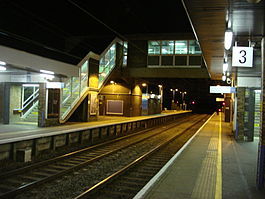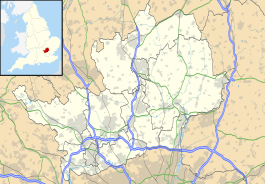Broxbourne railway station is on the West Anglia Main Line serving the towns of Broxbourne and Hoddesdon in Hertfordshire, England. It is 17 miles 17 chains (27.7 km) down the line from London Liverpool Street and is situated between Cheshunt and Roydon. Its three-letter station code is BXB and it is in fare zone B.
| Broxbourne | |
|---|---|
 | |
| Location | Broxbourne |
| Local authority | Borough of Broxbourne |
| Grid reference | TL374072 |
| Managed by | Greater Anglia |
| Station code(s) | BXB |
| DfT category | C2 |
| Number of platforms | 4 |
| Accessible | Yes[1] |
| Fare zone | B |
| National Rail annual entry and exit | |
| 2019–20 | |
| – interchange | |
| 2020–21 | |
| – interchange | |
| 2021–22 | |
| – interchange | |
| 2022–23 | |
| – interchange | |
| 2023–24 | |
| – interchange | |
| Railway companies | |
| Original company | Northern and Eastern Railway |
| Pre-grouping | Great Eastern Railway |
| Post-grouping | London and North Eastern Railway |
| Key dates | |
| 15 September 1840 | Opened as Broxbourne & Hoddesdon |
| 4 May 1970 | Renamed Broxbourne[3] |
| Other information | |
| External links | |
| Coordinates | 51°44′49″N 0°00′40″W / 51.747°N 0.011°W |
The station and all trains serving it are operated by Greater Anglia.
History
editBroxbourne station was officially opened by the Northern and Eastern Railway on 15 September 1840. It was on the company's proposed line to Cambridge, but the next section of the line to Latton Mill (Harlow) was not opened until August 1841. Therefore, for a short period of time Broxbourne was the terminus for the line which ran up the Lea Valley from Stratford Junction, where it joined the Eastern Counties Railway. The original station building was demolished in 1959 and replaced with new buildings designed by H. H. Powell, of the British Railways Eastern Region Architects' Department[4] with T. Rainier as the Project Architect.
The station was Grade II listed in March 2009;[5] "one of a very small number of post-war railway stations of clear architectural distinction".[6]
Ticket barriers were installed in 2011.
The centre platforms (platforms 2 and 3) were extended to accommodate 12-coach trains in December 2011, though initially no 12-coach trains were scheduled to call.
Of the four platforms, platform 1 is used by terminating or starting services to and from Liverpool Street, Stratford and Hertford East, platform 2 is used by services to Liverpool Street and Stratford, platform 3 is used by services to Hertford East, Cambridge and Bishops Stortford, and platform 4 is used by services to Hertford East and Bishops Stortford.
Services
editThe typical Monday-Saturday off-peak service is:
- 4 tph (trains per hour) to London Liverpool Street, of which:
- 2 call at Cheshunt and Tottenham Hale, taking 28 minutes.
- 2 call at Cheshunt, Waltham Cross, Enfield Lock, Brimsdown, Ponders End, Tottenham Hale and Hackney Downs, taking 36 minutes.
- 2 tph to Stratford, of which
- 1 calls at Cheshunt, Enfield Lock, Northumberland Park, Tottenham Hale and Lea Bridge.
- 1 calls at Cheshunt, Waltham Cross, Tottenham Hale and Lea Bridge.
- 2 tph to Hertford East, calling at Rye House, St Margarets and Ware, taking 17 minutes.
- 2 tph to Bishops Stortford, of which:
- 1 calls at Roydon, Harlow Town, Harlow Mill and Sawbridgeworth
- 1 calls at Harlow Town and Sawbridgeworth
- 1 tph to Cambridge North calling at Harlow Town, Bishop's Stortford, Audley End and Whittlesford Parkway, taking 46 minutes.
- 1 tph to Cambridge North which calls at Roydon, Harlow Town, Harlow Mill, Sawbridgeworth, Bishop's Stortford, Stansted Mountfitchet, Elsenham, Newport, Audley End, Great Chesterford, Whittlesford Parkway, Shelford and Cambridge taking 60 minutes.
In the peak selected services continue further to Waterbeach before terminating at Ely. Additional services also run southbound in the morning peaks.
On Sundays the general service pattern is:
- 2 tph to London Liverpool Street, of which:
- 1 calls at Cheshunt and Tottenham Hale, taking 30 minutes.
- 1 calls at Cheshunt, Tottenham Hale and Hackney Downs.
- 2 tph to Stratford, calling at Cheshunt, Waltham Cross, Enfield Lock, Brimsdown, Ponders End, Tottenham Hale and Lea Bridge.
- 2 tph to Hertford East as above, taking 18 minutes.
- 1 tph to Cambridge North, of calling at Harlow Town, Sawbridgeworth, Bishop's Stortford, Audley End Whittlesford Parkway and Shelford.
- 1 tph to Cambridge North which calls at all stations (as above).
| Preceding station | National Rail | Following station | ||
|---|---|---|---|---|
| Cheshunt | Greater Anglia |
Roydon or Harlow Town | ||
| Greater Anglia | ||||
References
edit- ^ "Broxbourne (BXB)". National Rail Enquiries. Archived from the original on 23 August 2017.
- ^ a b c d e f g h i j "Estimates of station usage". Rail statistics. Office of Rail Regulation. Please note: Some methodology may vary year on year.
- ^ Quick, M E (2002). Railway passenger stations in England, Scotland and Wales - a chronology. Richmond: Railway and Canal Historical Society. p. 100. OCLC 931112387.
- ^ Pevsner, Nikolaus; Cherry, Brigit (2002). The Buildings of England: Hertfordshire. Yale University Press. p. 115. ISBN 0300096119.
- ^ Broxbourne Borough Council. "Press Release: Broxbourne Railway Station is designated as a Grade II listed building". Retrieved 7 June 2009. [dead link]
- ^ Stuff, Good. "Broxbourne Railway Station, Broxbourne, Hertfordshire". britishlistedbuildings.co.uk.
External links
edit- Train times and station information for Broxbourne railway station from National Rail
